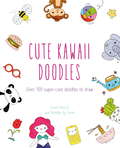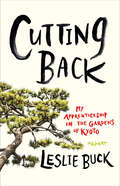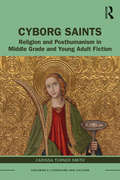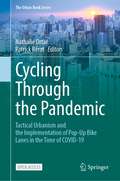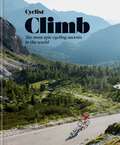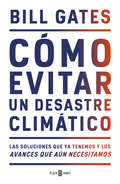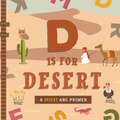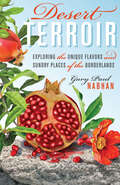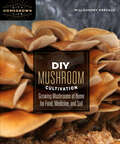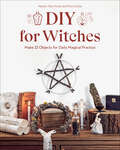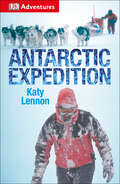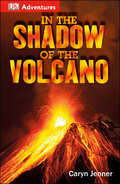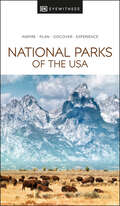- Table View
- List View
Cute Kawaii Doodles
by Sarah AlbertoBursting with ideas for illustrators and those who have never sketched before, this inspirational book will teach you how to draw more than 100 adorable doodles and super-cute characters in just a few easy steps. Starting with a simple shape such as a circle or a square, Sarah Alberto - aka Doodles by Sarah - shows you how to transform these into a quirky plant, a cute donut, a characterful face, a dainty cloud, and much, much more.Annotated with quick tips and tricks to explain the process, the visual steps will show you how to create a whole host of charming characters, using the ubiquitous ballpoint pen. Why a ballpoint pen? It's universal, affordable, and versatile, and allows you to create small details and sharp lines. Sarah also demonstrates how you can also use coloured pencils or markers to add extra life to your completed doodles.With the author's engaging, sweet and simple style, you'll be instantly inspired to pick up a pen and some paper and doodle like you've never done before!
Cutting Back: My Apprenticeship in the Gardens of Kyoto
by Leslie Buck“An unusual and entertaining memoir.” —New York Times Book Review At thirty-five, Leslie Buck made an impulsive decision to put her personal life on hold to pursue her passion. Leaving behind a full life of friends, love, and professional security, she became the first American woman to learn pruning from one of the most storied landscaping companies in Kyoto. Cutting Back recounts Buck’s bold journey and the revelations she has along the way. During her apprenticeship in Japan, she learns that the best Kyoto gardens look so natural they appear untouched by human hands, even though her crew spends hours meticulously cleaning every pebble in the streams. She is taught how to bring nature’s essence into a garden scene, how to design with native plants, and how to subtly direct a visitor through a landscape. But she learns the most important lessons from her fellow gardeners: how to balance strength with grace, seriousness with humor, and technique with heart.
Cutting Green Tape: Pollutants, Environmental Regulation and the Law
by Richard L. Stroup Roger E. MeinersHundreds of hazardous waste sites are on the Superfund National Priority List in the United States, and thousands more could become eligible. The Superfund has spent or ordered the spending of billions of dollars, with little apparent impact on human health risks. While public perception of the real or imagined hazardous nature of consumer and industrial substances has resulted in widespread attention to the issue, lawsuits have proliferated with liability aimed at "deep pockets" instead of individual agents who may be responsible. Contributors to Cutting Green Tape carefully examine the existence and severity of the toxic harms and liability problem, the erosion of a clear tort legal system to settle disputes, and whether a clearly defined system of property rights could be developed to reduce the dangers from toxic substances.Cutting Green Tape rethinks the nature and impact of today's environmental bureaucracy. Rather than continue unworkable, cumbersome, and often contradictory regulations, Cutting Green Tape prescribes a clearer tort legal system to settle disputes and demonstrates that clearly defined environmental property rights would reduce the threat of toxic substances. Among the many topics addressed are: air toxins policy; pollution, damages, and tort law; risk assessment, insurance, and public information; protecting groundwater; regulation of carcinogens; contracting for health and safety; and toxin torts by government.The book converges on a central theme: when common law remedies, with their burden of proof and standards of evidence, are replaced by the legislatively mandated regulatory regimes described, a problem emerges. The bureaucratic "tunnel vision" described by Justice Stephen Breyer, tends to take over. The police powers of the state are given to bureaucratic decision makers who are limited only by the blunt instrument of political influence, rather than by the need to show harm or wrongdoing in an unbiased court (as the police are), or by a budget on expenditures set by the Congress (as most bureaus are). The excesses described in the chapters thus result not from incompetence in the bureaus, but from the expansive powers granted to decision makers who are tightly focused on the narrow mission they see before them.
Cybernetics and the Constructed Environment: Design Between Nature and Technology
by Zihao ZhangGrounded in contemporary landscape architecture theory and practice, Cybernetics and the Constructed Environment blends examples from art, design, and engineering with concepts from cybernetics and posthumanism, offering a transdisciplinary examination of the ramifications of cybernetics on the constructed environment. Cybernetics, or the study of communication and control in animals and machines, has grown increasingly relevant nearly 80 years after its inception. Cyber-physical systems, sensing networks, and spatial computing—algorithms and intelligent machines—create endless feedback loops with human and non-human actors, co-producing a cybernetic environment. Yet, when an ecosystem is meticulously managed by intelligent machines, can we still call it wild nature? Posthumanism ideas, such as new materialism, actor-network theory, and object-oriented ontology, have become increasingly popular among design disciplines, including landscape architecture, and may have provided transformative frameworks to understand this entangled reality. However, design still entails a sense of intentionality and an urge to control. How do we, then, address the tension between the designer’s intentionality and the co-produced reality of more-than-human agents in the cybernetic environment? Is posthumanism enough to develop a framework to think beyond our all-too-human ways of thinking? For researchers, scholars, practitioners, and students in environmental design and engineering disciplines, this book maps out a paradigm of environmentalism and ecological design rooted in non-communication and uncontrollability, and puts a speculative turn on cybernetics.Chapters 8 and 9 of this book are freely available as a downloadable Open Access PDF at http://www.taylorfrancis.com under a Creative Commons Attribution-Non Commercial-No Derivatives (CC-BY-NC-ND) 4.0 license.
Cyborg Saints: Religion and Posthumanism in Middle Grade and Young Adult Fiction (Children's Literature and Culture)
by Carissa Turner SmithSaints are currently undergoing a resurrection in middle grade and young adult fiction, as recent prominent novels by Socorro Acioli, Julie Berry, Adam Gidwitz, Rachel Hartman, Merrie Haskell, Gene Luen Yang, and others demonstrate. Cyborg Saints: Religion and Posthumanism in Middle Grade and Young Adult Fiction makes the radical claim that these holy medieval figures are actually the new cyborgs in that they dethrone the autonomous subject of humanist modernity. While young people navigate political and personal forces, as well as technologies, that threaten to fragment and thingify them, saints show that agency is still possible outside of the humanist construct of subjectivity. The saints of these neomedievalist novels, through living a life vulnerable to the other, attain a distributed agency that accomplishes miracles through bodies and places and things (relics, icons, pilgrimage sites, and ultimately the hagiographic text and its reader) spread across time. Cyborg Saints analyzes MG and YA fiction through the triple lens of posthumanism, neomedievalism, and postsecularism. Cyborg Saints charts new ground in joining religion and posthumanism to represent the creativity and diversity of young people’s fiction.
Cycling Through the Pandemic: Tactical Urbanism and the Implementation of Pop-Up Bike Lanes in the Time of COVID-19 (The Urban Book Series)
by Patrick Rérat Nathalie OrtarThis open access book provides insight on how the tactical urbanism has the capacity to influence change in mobility practices such as cycling. COVID-19 crisis prompted the public authorities to rethink the use of public space in order to develop means of transport that are both efficient and adapted to the health context and their effects on cycling practices in Europe, North, and South America. Its contributors collectively reveal and evidence through policies analysis, mapping, and innovative qualitative analysis bridging video and interviews, how those new infrastructures and policies can be a trigger for change in a context of mobility transition.This book provides an important element on the way local authorities can act in a quicker and more agile way. While some decisions are specific to the context of the beginning of the pandemic, the analysis offers lessons on the way to implement the transition toward a low-carbon mobility, on the importance of processes based on trials and errors, on the political stakes of reallocating road space.
Cycling and Recycling: Histories of Sustainable Practices (Environment in History: International Perspectives #7)
by Ruth Oldenziel Helmuth TrischlerTechnology has long been an essential consideration in public discussions of the environment, with the focus overwhelmingly on creating new tools and techniques. In more recent years, however, activists, researchers, and policymakers have increasingly turned to mobilizing older technologies in their pursuit of sustainability. In fascinating case studies ranging from the Early Modern secondhand trade to utopian visions of human-powered vehicles, the contributions gathered here explore the historical fortunes of two such technologies—bicycling and waste recycling—tracing their development over time and providing valuable context for the policy successes and failures of today.
Cycling: Merit Badge Series
by Boy Scouts of AmericaA guide for completing the cycling merit badge for Boy Scouts.
Cyclist - Climb: The most epic cycling ascents in the world
by CyclistExplore 35 of the most notorious, gruelling cycling climbs the world has to offer, guided by the experts at Cyclist, the world's biggest road cycling magazine.Route maps, altitude charts, first-hand ride reports and incredible imagery from the finest cycling photographers combine in this tribute to the peaks, hills and ascents that every cyclist should try.Tracing the routes of the greatest rides across France, Italy, Spain and Belgium, this beautiful book also includes lesser-known climbs covering northern and eastern Europe and the USA - with every single ride tried, tested and conquered by the experts at Cyclist magazine.Climbs include:Monte Grappa, ItalyZoncolan, ItalyPasso dello Stelvio, ItalyAlto de l'Angliru, SpainSa Calobra, SpainKoppenberg, BelgiumAlpe d'Huez, FranceCol Agnel, FranceCroix de Fer, FranceThe Trollstigen, NowayMauna Kea, USA
Cyclist - Climb: The most epic cycling ascents in the world
by CyclistExplore 35 of the most notorious, gruelling cycling climbs the world has to offer, guided by the experts at Cyclist, the world's biggest road cycling magazine.Route maps, altitude charts, first-hand ride reports and incredible imagery from the finest cycling photographers combine in this tribute to the peaks, hills and ascents that every cyclist should try.Tracing the routes of the greatest rides across France, Italy, Spain and Belgium, this beautiful book also includes lesser-known climbs covering northern and eastern Europe and the USA - with every single ride tried, tested and conquered by the experts at Cyclist magazine.Climbs include:Monte Grappa, ItalyZoncolan, ItalyPasso dello Stelvio, ItalyAlto de l'Angliru, SpainSa Calobra, SpainKoppenberg, BelgiumAlpe d'Huez, FranceCol Agnel, FranceCroix de Fer, FranceThe Trollstigen, NowayMauna Kea, USA
Cómo cuidar de la carpa Koi (Cómo hacer... #1)
by Owen Jones¡Hola! Gracias por comprar este libro electrónico llamado 'Cómo cuidar de la Carpa Koi'. Espero que la información le resulte útil y provechosa. El contenido de este libro electrónico sobre estanques de jardín Koi y otros temas relacionados está agrupado en dieciocho capítulos, que le ayudarán a elegir un sitio para su estanque de carpas Koi, cómo montarlo y mantenerlo durante todo el año. También aprenderá a cuidar de sus valiosos peces durante las diferentes estaciones del año e incluso en condiciones adversas. Le puede ayudar a iniciar una nueva profesión o como mínimo le ayudará a ahorrar cien veces más en asesoramiento profesional. Como incentivo adicional, le doy permiso para usar el contenido en su propio sitio web o en sus blogs y sus boletines, aunque es mejor si lo vuelve a escribir con sus propias palabras primero. También puede dividir el libro y revender los artículos. De hecho, el único derecho del que no puede disfrutar es el de revender o regalar el libro tal como se le entregó. Si tiene algún comentario, por favor, envíelo a la compañía donde compró este libro o envíelo a owen@amiabledragon.com Puede encontrar más libros como este donde lo compró. Gracias de nuevo por comprar este libro electrónico, Atentamente, Owen Jones.
Cómo estamos acabando con el planeta (How We're F***ing Up Our Planet): Guía gráfica del cambio climático
by Tony JuniperDiez millones de personas cada año se ven afectadas por inundaciones costeras y la contaminación por plásticos es una amenaza constante para la vida marina. La pandemia, el cambio climático, la superpoblación, el consumismo, la polución...¿tienen solución? Cómo estamos acabando con el planeta resuelve todas tus dudas sobre los retos y dificultades a los que se enfrenta el mundo en el que vivimos. - Imágenes, gráficos y datos claros para una mejor comprensión de aspectos como la polución, el calentamiento global, la deforestación o los patrones climáticos - Mensajes positivos e ideas para hacer de nuestro planeta un lugar mejor donde vivir - Cifras y comparativas por años de la población, del aumento de las energías renovables, de personas desplazadas... - Basado en las últimas investigaciones científicasEsta guía explicativa te invita a aprenderlo todo sobre los temas ambientales más actuales y a reflexionar cómo los problemas mundiales impactan nuestras vidas.
Cómo evitar un desastre climático
by Bill GatesEn este libro urgente y necesario Bill Gates propone un plan amplio, práctico y comprensible para conseguir que el mundo llegue a cero emisiones de gases de efecto invernadero para así evitar una catástrofe climática. Bill Gates ha pasado una década investigando las causas y efectos del cambio climático. Con la ayuda de expertos en los campos de la física, la química, la biología, la ingeniería, las ciencias políticas y las finanzas, se ha centrado en investigar exactamente qué se debe hacer para detener la deriva del planeta hacia un desastre ambiental. En este libro, además de explicar por qué debemos esforzarnos en lograr emisiones netas cero de gases de efecto invernadero, también detalla lo que debemos hacer para lograr este objetivo tan importante. Gates nos presenta una descripción clara de los desafíos que enfrentamos. A partir de su conocimiento sobre innovación y lo que se requiere para introducir nuevas ideas en el mercado, describe las áreas en las que la tecnología ya está ayudando a reducir las emisiones, dónde y cómo la tecnología actual puede funcionar de manera más eficaz, dónde es necesario desarrollar tecnologías de punta, y quién está trabajando en estas innovaciones esenciales. Finalmente, presenta un plan concreto y práctico para lograr el objetivo de cero emisiones, sugiriendo no solo las políticas que los gobiernos deberían adoptar, sino lo que nosotros, como individuos, podemos hacer para que nuestro gobierno, nuestros empleadores y nosotros mismos nos responsabilicemos esta crucial iniciativa. Como deja claro Bill Gates, llegar a cero emisiones no será sencillo ni fácil, pero si seguimos el plan que aquí propone, es una meta que se encuentra decididamente a nuestro alcance. Para detener el calentamiento global y evitar los peores efectos del cambio climático, los humanos deben dejar de agregar gases de efecto invernadero a la atmósfera. Si nada cambia, el mundo seguirá produciendo gases de efecto invernadero, el cambio climático seguirá empeorando y el impacto en los seres humanos con toda probabilidad será catastrófico. Pero las cosas pueden cambiar. Este libro trata sobre lo que se necesitará para lograrlo y por qué estoy convencido de que podemos hacerlo. -- Bill Gates
Cómo evitar un desastre climático: Las soluciones que ya tenemos y los avances que aún necesitamos
by Bill GatesEn este libro tan necesario y riguroso, Bill Gates expone un plan amplio, funcional y, sobre todo, asequible, para reducir a cero las emisiones de los gases causantes del efecto invernadero y evitar a tiempo una catástrofe medioambiental. Bill Gates ha dedicado una década a investigar el cambio climático. Con la orientación de expertos en física, química, biología, ingeniería, ciencias políticas y finanzas, se ha centrado en determinar qué medidas debemos tomar para detener la carrera del planeta hacia un desastre ambiental irreversible. En este libro, el autor no solo reúne la información básica para que tomemos conciencia de la necesidad de eliminar las emisiones de los gases causantes del efecto invernadero, sino que también explica qué debemos hacer para alcanzar este objetivo tan importante. Gates nos ofrece una descripción lúcida de los desafíos a los que nos enfrentamos. Aprovechando sus conocimientos en innovación y en lo que supone introducir nuevos conceptos en el mercado, nos detalla cuáles son los campos en los que la tecnología ya está ayudando a reducir las emisiones, cómo y cuándo se logrará que la tecnología actual sea más eficaz, dónde necesitamos dichos avances y quiénes están trabajando en estas mejoras tan necesarias. Por último, traza un plan práctico y específico para llegar a las cero emisiones, tanto con políticas gubernamentales como a título personal, implicando así a gobiernos, a empresas y a nosotros mismos en esta crucial misión. Como advierte Bill Gates, cumplir el objetivo de las cero emisiones no será una tarea sencilla, pero sí está a nuestro alcance si seguimos sus pautas.
Cómo funciona el mundo: Una guía científica de nuestro pasado, presente y futuro
by Vaclav SmilUnsinceroy revelador análisis de las posibilidades energéticas de nuestro futuro.«Sitepreocupael futuro y te enfurece que no se esté haciendo suficiente al respecto, por favor, lee este libro».Paul CollierVaclav Smil lleva cincuenta años estudiando las posibilidades que tenemos a nuestro alcance para garantizar el futuro energético de nuestro planeta. Debido a la complejidad de las interacciones que mueven el mundo, la atomización del conocimiento y la volatilidadde la información es muy difícil anticipar con exactitud qué ocurrirá. Por eso es necesario ceñirse a los datos y a los límites quenos ofrece la ciencia,así como poner la atención en los escenarios más cercanos y menos idealistas para encarar los retos actuales de manera eficaz.Así pues, este libro aborda temas tan importantes como la improbable y difícil tarea de descarbonizar el planeta, en parte por la estrecharelación entre la producción de alimentos y los combustibles fósiles, pero también destapa realidades incómodas, como ladependenciade las economías modernas respecto de la alta producción de amoníaco, metal, cemento y plástico. Además, examina de qué formael calentamiento global puede afectar a nuestras necesidades básicas para sobreviviry anima a reevaluar los riesgos que hemos subestimado o exagerado a lo largo de los años para aprender a vivir más y mejor.Cómo funciona el mundo es literalmente un libro sobre cómo funciona el mundo. Por su estructura y clarividencia, sirve como unaguía interdisciplinaria que evita a toda costa dar eco a las posturas extremas y propone una respuesta objetiva, científica yrazonadaa todos los titulares que nos generan ansiedad: la crisis climática, la crisis energética, la crisis de materias primas, laglobalizacióny el futuro de nuestra civilización. El resultado es un poderoso ensayo que combina los más recientes descubrimientoscientíficos y el trabajo de quien ha investigado a lo largo de medio siglo los retos energéticos a los que nos enfrentamos. La crítica ha dicho:«Puedes estar o no de acuerdo con Smil; aceptar o desconfiar de su “solo los hechos”; pero no deberías ignorarlo».The Washington Post«Una guía en nuestra lucha contra el cambio climático que combina un análisis brutal y realista del presente y la confianza en la capacidad de los seres humanos para cambiar el futuro. Muy instructivo y revelador en muchos sentidos».Ha-Joon Chang, autor de 23 cosas que no te cuentan sobre el capitalismo«Cómofuncionael mundo cumple plenamente la promesa de su título. Es difícil formular un elogio mayor».Simon Ings, New Scientist«No soy ni pesimista ni optimista; soy un científico, escribe Smil en la introducción con la típica valentía Smiliana. De hecho, es más bien un numerista, un erudito con un don para triturar datos complejos con rigor y reducirlos a agradables bocados de información».Financial Times«Un maestro del análisis estadístico».The Guardian
D Is for Desert: An ABC Desert Primer
by Ashley Marie MirelesA is for armadillo B is for bedrock C is for cactus . . . With E for erosion, I for iguana, and P for prickly pear, going from A to Z has never been more fun in the sun! Take an alphabetized trip through the dunes and discover the plants, animals, and weather patterns that make the deserts of the world so amazing!
DESERT TERROIR: Exploring the Unique Flavors and Sundry Places of the Borderlands (Ellen and Edward Randall Series)
by Gary Paul NabhanWhy does food taste better when you know where it comes from? Because history-ecological, cultural, even personal-flavors every bite we eat. Whether it's the volatile chemical compounds that a plant absorbs from the soil or the stories and memories of places that are evoked by taste, layers of flavor await those willing to delve into the roots of real food. In this landmark book, Gary Paul Nabhan takes us on a personal trip into the southwestern borderlands to discover the terroir-the "taste of the place"-that makes this desert so delicious. To savor the terroir of the borderlands, Nabhan presents a cornucopia of local foods-Mexican oregano, mesquite-flour tortillas, grass-fed beef, the popular Mexican dessert capirotada, and corvina (croaker or drum fish) among them-as well as food experiences that range from the foraging of Cabeza de Vaca and his shipwrecked companions to a modern-day camping expedition on the Rio Grande. Nabhan explores everything from the biochemical agents that create taste in these foods to their history and dispersion around the world. Through his field adventures and humorous stories, we learn why Mexican oregano is most potent when gathered at the most arid margins of its range-and why foods found in the remote regions of the borderlands have surprising connections to foods found by his ancestors in the deserts of the Mediterranean and the Middle East. By the end of his movable feast, Nabhan convinces us that the roots of this fascinating terroir must be anchored in our imaginations as well as in our shifting soils.
DIY Mushroom Cultivation: Growing Mushrooms at Home for Food, Medicine, and Soil (Homegrown City Life)
by Willoughby Arevalo"Offering clear and comprehensive instructions for low-tech growing for a range of budgets, interests, and scales, this book offers practical inspiration and a sense that "hey, I can do this!" –— DANIELLE STEVENSON, owner, DIY FungiDIY Mushroom Cultivation is full of proven, reliable, low-cost techniques for home-scale cultivation that eliminate the need for a clean-air lab space to grow various mushrooms and their mycelium.Beautiful full-color photos and step-by-step instructions accompany a foundation of mushroom biology and ecology to support a holistic understanding of the practice. Growing techniques are applicable year-round, for any space from house to apartment, and for any climate, budget, or goal. Techniques include:Setting up a home growing spaceInexpensive, simple DIY equipmentCulture creation from mushroom tissue or sporesGrowing and using liquid cultures and grain spawnGrowing mushrooms on waste streams Indoor fruitingOutdoor mushroom gardens and logsHarvesting, processing, tinctures, and cooking.Whether you hunt mushrooms or dream about growing and working with them but feel constrained by a small living space, DIY Mushroom Cultivation is the ideal guide for getting started in the fascinating and delicious world of fungiculture.
DIY Succulents: From Placecards to Wreaths, 35+ Ideas for Creative Projects with Succulents
by Tawni DaigleAs featured in The Washington Post Dig into dozens of stunning succulent creations!Go beyond the garden to create succulent projects that take center stage in any space. DIY Succulents shows you how to use beautiful and resilient plants like echeveria, sedum, and graptopetalum to craft nature-inspired home decor like rustic tabletop centerpieces and breathtaking wall art. Each page offers details on selecting the right plants and containers for the project, assembling a gorgeous arrangement, and maintaining the garden as it grows. With step-by-step instructions, gardening tips, and dozens of ideas to choose from, anyone can create imaginative succulent crafts like:Living WreathBirch Log PlanterTerrarium NecklaceTopiary BallComplete with photos and plenty of inspiration, DIY Succulents will help you add creativity, color, and personality to every room in your home.
DIY for Witches: Make 22 Objects for Daily Magical Practice
by Marine Nina Denis Flora DenisWitches and wizards begin your magical journey! Welcome to the world of witchcraft! When you practice magic, you must surround yourself with essential objects that will accompany you in everyday life, as well as in your work and rituals. The most effective tools will be those that you take the time to lovingly craft and truly bond with, right from the start. Create 22 magical objects to make for ritual, divination, at home, and on the go. These are easy-to-make tools you’ll turn to again and again in your magic works and your rituals from magic candles and fumigation sticks to runes and oracles and much more. Start practicing witchcraft with this step-by-step introduction that lovingly introduces the craft Create 22 magical objects for ritual, divination, at home, and on the go Includes resources on pagan festivals for rituals, list of magical powers of plants, the meaning of colors, magic signs and symbols, and moon phases
DK Adventures: Antarctic Expedition (DK Adventures)
by DKExperience the harsh conditions of this polar landscape, discover how researchers survive, and find out about the intrepid explorers from the past who have set out to reach the South Pole.DK Adventures is a nonfiction series for kids ages 8-11 featuring visually rich theme spreads, and fascinating facts that help kids build their skills in vocabulary, grammar, comprehension, and critical thinking while developing a love of reading. Designed to keep interest high, build knowledge, and enrich the reading experience with fascinating background information, each title in the DK Adventures series is filled with information yet eminently accessible, and available in a wide range of kid-favorite topics including rain forests, animals, rocks, and shipwrecks.
DK Adventures: Awesome Rocks (DK Adventures)
by Katy LennonLook up close at rocks, minerals and sparkling gems to unravel the clues to classify and identify them. Find out how they were formed, where in the world they're found and how to start your own rock collection.DK Adventures is a nonfiction series for kids ages 8-11 featuring visually rich theme spreads, and fascinating facts that help kids build their skills in vocabulary, grammar, comprehension, and critical thinking while developing a love of reading. Designed to keep interest high, build knowledge, and enrich the reading experience with fascinating background information, each title in the DK Adventures series is filled with information yet eminently accessible, and available in a wide range of kid-favorite topics including rain forests, animals, rocks, and shipwrecks.
DK Adventures: In the Shadow of the Volcano (DK Adventures)
by Caryn JennerIn a modern-day adventure of an eruption of Mount Vesuvius, a volcanologist and her son are caught up in the drama as the volcano re-awakens. The mayor is reluctant to cancel the village festival despite her warnings of an imminent eruption. Will he and the other villagers escape in time, before the explosive volcano wreaks havoc? Find out in DK Adventures: In the Shadow of the Volcano. DK Adventures are an innovative mix of narrative and nonfiction for kids ages 8-11 featuring engaging, action-packed stories that help kids build their skills in vocabulary, grammar, comprehension, and critical thinking while developing a love of reading. With diaries, recipes, poetry, instructions, graphics, or songs, the genre spreads in each DK Adventures title enhance the story and reinforce curriculum learning, while the expansive range of entertaining nonfiction subjects will appeal to boys and girls everywhere. Supports the Common Core State Standards.
DK Adventures: Jungle Adventures (DK Adventures)
by Katy LennonIs your child interested in surviving in the jungle and learning about jungle animals? DK Adventures: Jungle Adventures is the perfect book for learning more about the jungle! This book combines story and visual elements to appeal to both avid readers and visual learners. With the jungle facts and adventures story in DK Adventures: Jungle Adventure, kids might not realize they're learning at all! In DK Adventures: Jungle Adventure, we join Charlotte and a team of scientists on an expedition to explore Cambodia's wildlife. Learn how to survive and how to find animals in the jungle. Experience the mosquitoes, snakes, and torrential rain of the rainforest, and join the team as they encounter frogs, monkeys, and even a tiger! Kids will be excited about discovering the elusive Siamese crocodile, and will be eager to see if Charlotte can overcome her fear of camping. DK Adventures is a book series that reluctant readers can enjoy as much as bookworms do! This series combines captivating, fictional stories with nonfiction facts to encourage learning and engagement in your child. The stories keep children interested, and the facts teach critical skills and knowledge — the fiction and nonfiction elements work together to keep each child's interest high, to build knowledge, and to enrich the narrative reading experience with fascinating background information. These books are filled with information, but the stories make them incredibly readable. DK Adventures are available in a range of kid-friendly topics, including dinosaurs, cars, and the human body, and each book supports Common Core State Standards and literacy skills.
DK Eyewitness National Parks of the USA (Travel Guide)
by DK EyewitnessGet closer to USA's National Parks with DK EyewitnessA night spent stargazing in Joshua Tree. Standing on the rim of the Grand Canyon. Wildlife spotting from an airboat in the Everglades. With 63 national parks to explore, the USA offers enough bucket-list experiences to fill a lifetime. Whether you plan to visit them all, or choose a few favourites, this DK Eyewitness travel guide is the perfect companion.This new, first edition brings the parks to life, transporting you to each one like no other travel guide does with expert-led insights, trusted travel advice, detailed maps, photographs on practically every page, and our hand-drawn illustrations, which explain the parks' unique geology.You'll discover:Our pick of the top experiences to have in the national parksBeautiful photography and detailed illustrations, taking you to the heart of the parksThe best spots to eat, drink, shop and stayDetailed maps and tours which make navigating the parks easyEasy-to-follow itinerariesExpert advice: get ready, get around and stay safeA lightweight format, so you can take it with you wherever you goSpending more time in the USA? Try DK Eyewitness USA.DK is the world's leading illustrated reference publisher, producing beautifully designed books for adults and children in over 120 countries.
